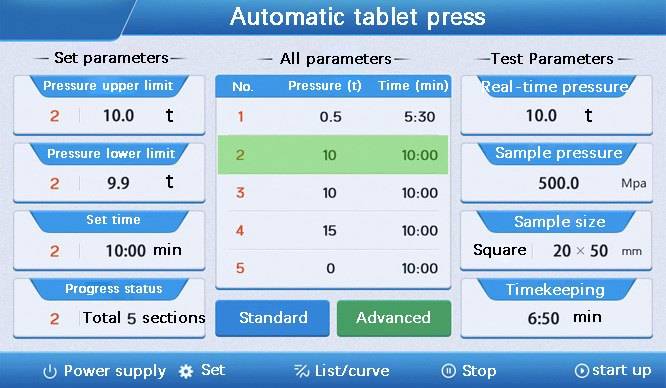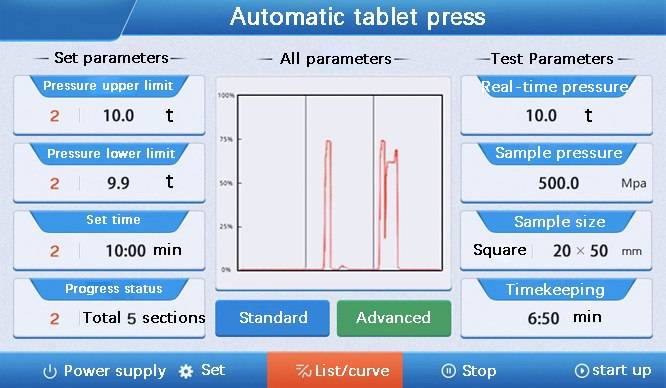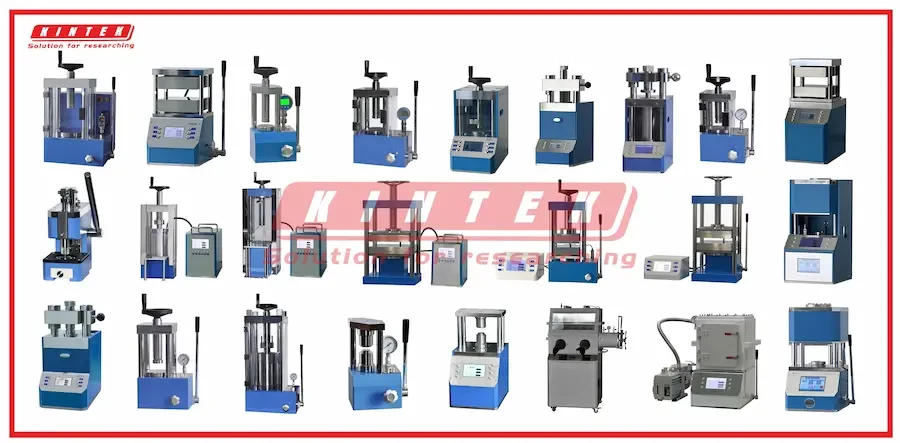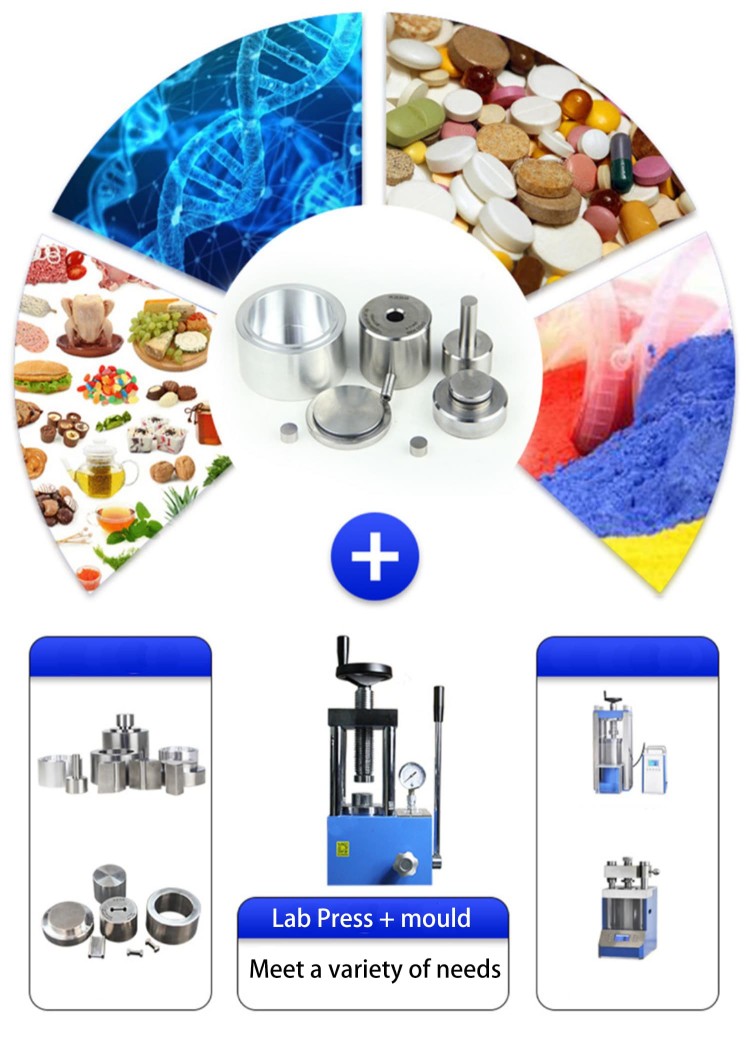
Electric Lab Press
Laboratory Hydraulic Press Split Electric Lab Pellet Press
Item Number : PCES
Price varies based on specs and customizations
- Working pressure
- 0-200T
- Cylinder stroke
- 50mm
- Piston diameter
- 130-290mm
Shipping:
Contact us to get shipping details Enjoy On-time Dispatch Guarantee.
Why Choose Us
Reliable PartnerEasy ordering process, quality products, and dedicated support for your business success.
Applications
The split electric laboratory press finds wide application in material research labs, pharmacy, catalytic reaction, ceramics, and electronic industries. It is a highly efficient equipment for sample preparation due to its compact size and portability. Moreover, it can operate inside the vacuum glove box, facilitating processing under vacuum conditions. Additionally, the hydraulic press functionality with heating plates enables hot press processing, which is particularly useful for specific materials.
Compared to integrated tablet presses, the split electric laboratory press can generate higher pressures and is more versatile.
Feature
- Small footprint, light weight, easy to carry and move, nice fitting vacuum glove box
- Both electric driving and manual press are available, high precision digital pressure gauge
- Pressure can be programmed, hydraulic will restart working when pressure drops to set value
- Can generate higher pressures and is more versatile
Detail & Parts



Operation interface

- Standard interface: You can set various parameters, pressure, demolding, time, sample size, etc. in this interface.
- Pressurization button: Pressurize according to the parameters set in the interface.
- Stop button: Press the stop button to stop pressurization during pressurization.
- Demolding button: Press the demolding button to demold the sample according to the demolding pressure.
- Timing switch: You can turn the timing function on and off.

- Start button: Pressurize according to multiple pressurization programs.
- Stop button: During pressurization, you can stop the pressurization process.
- Setting button: Click the setting button to enter the setting menu.

- List/curve: You can switch between list and curve display.
Advantages
- The upper plate adopts electroplated countersunk head hexagonal screws, beautiful and space-saving
- Chrome-plated cylinder, smooth surface, no rust, good sealing rubber ring, no oil leakage
- One-piece main board structure, oil pool, main board, oil cylinder in a body, no seal connection
- Extended pulling spring, good rebound effect, not easy to deformation, can achieve the cylinder 30mm return without deformation
- All aluminum alloy hand wheel, beautiful, practical, not easy to break
- Small size, light weight, no oil leakage, can be used in the glove box
- Mold using Japanese high-speed steel, good material, high hardness, no deformation, long service life
- Digital display pressure gauge, more accurate pressure control, pressure display accuracy of 0.01MPa
- Oil pool outside the host, easy to replace the oil, and the oil circuit increased the hydraulic oil filtration device
- Special plunger, using special custom sealing structure, excellent sealing effect
Technical specifications
| Instrument model | PCES-40T | PCES-65T | PCES-100T | PCES-150T | PCES-200T |
|---|---|---|---|---|---|
| Pressure Range | 0-40 tons | 0-65tons | 1-100tons | 1-150tons | 1-200tons |
| Piston diameter | 130mm (d) | 160mm (d) | 200mm (d) | 250mm (d) | 290mm (d) |
| Pressurization process | Program pressurization | Program pressurization | Program pressurization | Program pressurization | Program pressurization |
| Pressure conversion | Automatically converted pressure | Automatically converted pressure | Automatically converted pressure | Automatically converted pressure | Automatically converted pressure |
| Display | 7-inch LCD | 7-inch LCD | 7-inch LCD | 7-inch LCD | 7-inch LCD |
| Equipment protection | Steel plate protection with organic glass door | Steel plate protection with organic glass door | Steel plate protection with organic glass door | Steel plate protection with organic glass door | Steel plate protection with organic glass door |
| Cylinder stroke (T) | 50mm | 50mm | 50mm | 50mm | 50mm |
| Space size | 160×300mm(M×N) | 220×300mm(M×N) | 260×250mm(M×N) | 285×290mm(M×N) | 290×300mm(M×N) |
| External dimensions | 500×700×800mm(L×W×H) | 580×700×800mm(L×W×H) | 850×500×950mm(L×W×H) | 950×600×1000mm(L×W×H) | 1000×650×1050mm(L×W×H) |
| Power supply | 1500W(220V/110V) | 1500W(220V/110V) | 1500W(220V/110V) | 1500W(220V/110V) | 1500W(220V/110V) |
| Weight | 200kg | 280kg | 520kg | 620kg | 850kg |

Operating steps
How to replace accessories and precautions
The operation of Electric Split Lab Isostatic Press is as follows:

1. Load the sample into the mold.

2. Place the mold into the tablet press.

3. Enter the pressure to be applied.

4. Click Start to start pressurization.

5. After the pressurization stops, remove the mold.

6. Remove the bottom of the mold. Install the film removal sleeve.

7. Place the mold to be demolded into the tablet press.

8. Remove the pressed sample.
Full range of lab press types

Click to view our full range of lab press products.
Any question? Our experts have helped many laboratories choose their lab press, contact us now!
Full range of types of laboratory press molds
We have a full range of molds for you to choose from, and the molds fit the body perfectly.
If you need molds with special shapes, we can also customize them for you.

Warnings
Operator safety is the top important issue! Please operate the equipment with cautions. Working with inflammable& explosive or toxic gases is very dangerous, operators must take all necessary precautions before starting the equipment. Working with positive pressure inside the reactors or chambers is dangerous, operator must fellow the safety procedures strictly. Extra caution must also be taken when operating with air-reactive materials, especially under vacuum. A leak can draw air into the apparatus and cause a violent reaction to occur.
Designed for You
KinTek provide deep custom made service and equipment to worldwide customers, our specialized teamwork and rich experienced engineers are capable to undertake the custom tailoring hardware and software equipment requirements, and help our customer to build up the exclusive and personalized equipment and solution!
Would you please drop your ideas to us, our engineers are ready for you now!
FAQ
What Is A Lab Press?
What Is The Purpose Of A Hydraulic Press In Lab?
What Are The Applications Of Pellet Presses?
What Are Different Type Of Lab Presses?
How Does A Pellet Press Work?
What Are The Benefits Of Using A Pellet Press?
What Factors Should Be Considered When Selecting A Pellet Press?
4.8
out of
5
The electric laboratory pellet press from KINTEK is an exceptional tool for sample preparation. Its compact size and portability make it easy to use in various settings, including inside a vacuum glove box.
4.9
out of
5
The split electric laboratory pellet press from KINTEK is a game-changer for our lab. It has significantly improved the efficiency and accuracy of our sample preparation process.
4.7
out of
5
The KINTEK electric laboratory pellet press is a reliable workhorse in our lab. It consistently produces high-quality pellets, making it an indispensable tool for our research.
4.6
out of
5
The KINTEK split electric laboratory pellet press is a valuable addition to our lab equipment. It is easy to use and maintain, and it produces excellent results.
4.8
out of
5
The KINTEK electric laboratory pellet press is a great investment for any lab that needs to prepare high-quality pellets. It is durable, reliable, and easy to use.
4.9
out of
5
The KINTEK split electric laboratory pellet press is a must-have for any lab that performs XRF analysis. It is a powerful and versatile tool that makes sample preparation a breeze.
4.7
out of
5
The KINTEK electric laboratory pellet press is a great choice for labs that need to prepare small batches of pellets. It is compact and easy to use, and it produces consistent results.
4.6
out of
5
The KINTEK split electric laboratory pellet press is a great value for the price. It is a well-made and durable piece of equipment that will last for years to come.
4.8
out of
5
The KINTEK electric laboratory pellet press is a top-of-the-line product. It is easy to use and produces high-quality pellets. I highly recommend it to any lab that needs a reliable and durable pellet press.
4.9
out of
5
The KINTEK split electric laboratory pellet press is a game-changer for our lab. It has made sample preparation so much easier and faster.
4.7
out of
5
The KINTEK electric laboratory pellet press is a great investment for any lab that needs to prepare high-quality pellets. It is easy to use and maintain, and it produces excellent results.
4.6
out of
5
The KINTEK split electric laboratory pellet press is a valuable addition to our lab equipment. It is easy to use and maintain, and it produces excellent results.
4.8
out of
5
The KINTEK electric laboratory pellet press is a great choice for labs that need to prepare small batches of pellets. It is compact and easy to use, and it produces consistent results.
4.9
out of
5
The KINTEK split electric laboratory pellet press is a great value for the price. It is a well-made and durable piece of equipment that will last for years to come.
4.7
out of
5
The KINTEK electric laboratory pellet press is a top-of-the-line product. It is easy to use and produces high-quality pellets. I highly recommend it to any lab that needs a reliable and durable pellet press.
4.6
out of
5
The KINTEK split electric laboratory pellet press is a game-changer for our lab. It has made sample preparation so much easier and faster.
REQUEST A QUOTE
Our professional team will reply to you within one business day. Please feel free to contact us!
Related Products

Automatic Laboratory Hydraulic Pellet Press Machine for Lab Use
Experience efficient sample preparation with our Automatic Lab Press Machine. Ideal for material research, pharmacy, ceramics, and more. Features a compact size and hydraulic press functionality with heating plates. Available in various sizes.

Laboratory Hydraulic Press Lab Pellet Press Machine for Glove Box
Controlled environment lab press machine for glove box. Specialized equipment for material pressing and shaping with high precision digital pressure gauge.

Laboratory Hydraulic Pellet Press for XRF KBR FTIR Lab Applications
Efficiently prepare samples with the Electric Hydraulic Press. Compact and portable, it's perfect for labs and can work in a vacuum environment.

Automatic Laboratory Hydraulic Press for XRF & KBR Pellet Press
Fast and easy xrf sample pellet preparation with KinTek Automatic Lab Pellet Press. Versatile and accurate results for X-ray fluorescence analysis.

Introducing the KINTEK KBR Press - a handheld laboratory hydraulic press designed for entry-level users.

Laboratory Manual Hydraulic Pellet Press for Lab Use
Efficient sample preparation with small footprint Manual Lab Hydraulic Press. Ideal for material researching labs, pharmacy, catalytic reaction, and ceramics.

Electric Heated Hydraulic Vacuum Heat Press for Lab
The Electric Vacuum Heat Press is a specialized heat press equipment that operates in a vacuum environment, utilizing advanced infrared heating and precise temperature control for high quality, rugged and reliable performance.

Laboratory Manual Hydraulic Pellet Press for Lab Use
Efficient Manure Lab Hydraulic Press with Safety Cover for sample preparation in material research, pharmacy, and electronic industries. Available in 15T to 60T.

Automatic Heated Hydraulic Press Machine with Heated Plates for Laboratory Hot Press 25T 30T 50T
Efficiently prepare your samples with our Automatic Heated Lab Press. With a pressure range up to 50T and precise control, it's perfect for various industries.

Heated Hydraulic Press Machine with Heated Plates Split Manual Laboratory Hot Press
Efficiently prepare your samples with our Split Manual Heated Lab Press. With a pressure range up to 40T and heating plates up to 300°C, it's perfect for various industries.

Laboratory Hydraulic Press Lab Pellet Press for Button Battery
Efficiently prepare samples with our 2T Button Battery Press. Ideal for material research labs and small-scale production. Small footprint, lightweight, and vacuum-compatible.

Heated Hydraulic Press Machine with Integrated Manual Heated Plates for Lab Use
Efficiently process heat-pressing samples with our Integrated Manual Heated Lab Press. With a heating range up to 500°C, it's perfect for various industries.

Automatic Heated Hydraulic Press Machine with Heated Plates for Laboratory Hot Press
The Automatic High Temperature Heat Press is a sophisticated hydraulic hot press designed for efficient temperature control and product quality processing.

Heated Hydraulic Press Machine with Heated Plates for Vacuum Box Laboratory Hot Press
Enhance your lab's precision with our lab press for vacuum box. Press pills and powders with ease and precision in a vacuum environment, reducing oxidation and improving consistency. Compact and easy to use with a digital pressure gauge.

Manual Heated Hydraulic Press Machine with Heated Plates for Laboratory Hot Press
The Manual Heat Press is a versatile piece of equipment suitable for a variety of applications, operated by a manual hydraulic system that applies controlled pressure and heat to the material placed on the piston.

Heated Hydraulic Press Machine with Heated Plates for Vacuum Box Laboratory Hot Press
The lab press for vacuum box is a specialized piece of equipment designed for laboratory use. Its main purpose is to press pills and powders according to specific requirements.

Explore versatile Hydraulic Hot Press molds for precise compression molding. Ideal for creating various shapes and sizes with uniform stability.

Lab Scale Rotary Single Punch Tablet Press Machine TDP Tablet Punching Machine
This machine is a single-pressure automatic rotating, continuous tableting machine that compresses granular raw materials into various tablets. It is mainly used for tablet production in the pharmaceutical industry, and is also suitable for chemical, food, electronics and other industrial sectors.

Rubber Vulcanizer Vulcanizing Machine Plate Vulcanizing Press for Lab
The Plate vulcanizing press is a kind of equipment used in the production of rubber products, mainly used for the vulcanization of rubber products. Vulcanization is a key step in rubber processing.
Related Articles

Why Your Lab Pellets Crack: The Hidden Physics of a Perfect Press
Stop blaming your powder. Discover the real reason your lab pellets fail and how a precision hydraulic press solves inconsistent sample prep for good.

Why Your Sample Prep Fails: The Hidden Flaw in Your Hydraulic Press
Frustrated with cracked pellets and inconsistent lab press results? Discover the hidden material flaw in your equipment and how to fix it for good.

The Physics of Flawless Materials: Deconstructing the Hydraulic Hot Press
Discover how the synergy of Pascal's Law and thermal energy in a hydraulic hot press enables precise, repeatable material bonding and forming.

Why Your Molding & Curing Results Are Inconsistent—And How to Fix It
Frustrated with warped parts and failed molding? Discover the hidden reason your hydraulic press may be the problem and how the right tool ensures consistent results.

Your Hydraulic Press Is Hot. Here’s Why It’s a Bigger Problem Than You Think.
Is your lab's hydraulic press overheating? Learn why this is a critical sign of wasted energy and impending failure, and how to fix it permanently.

Operating of Automatic Lab xrf Pellet Press
How to use the Automatic Lab xrf Pellet Press, including steel ring, plastic ring, boric acid mold

Hydraulic Tablet Press: Comprehensive Guide to Design, Operation, and Applications
Explore the advanced features, operational principles, and diverse applications of hydraulic tablet presses in various industries. Learn how these machines ensure high-quality tablet production with detailed insights.

How to choose a laboratory hot press
The laboratory hot pressing machine is suitable for laboratory users who are strict about sample pressing temperature, pressure control accuracy and need a wide size mold for pressing samples. The new lab hot press of KINDLE TECH has a double-plate structure and a pressing force of 0~40 tons.

Applications and Importance of Hydraulic Press in Laboratories
A hydraulic press is a machine that uses the pressure generated in a confined fluid to configure metals, plastics, rubber, and other materials. Its operation is governed by Pascal’s principle, which states that pressure applied to a confined fluid is transmitted unaltered throughout the fluid.

Operating steps and precautions for electric tablet press
Relevant introduction to the operating steps and precautions of electric tablet press.

Sample preparation and unloading method of electric tablet press
How to prepare and unloading the sample? When tablet pressing, the operator must set the parameters of pressure, speed, and time according to the process requirements, so that the formed tablets meet the requirements for strength, hardness, and weight.

The Benchtop KBr Pellet Press: An Efficient Tool for Laboratory Use
The benchtop KBr pellet press is a versatile and efficient tool that produces uniform pellets, ensuring consistent and reliable results. In addition, its adjustable mold can be used flexibly to accommodate a variety of sample sizes and shapes.